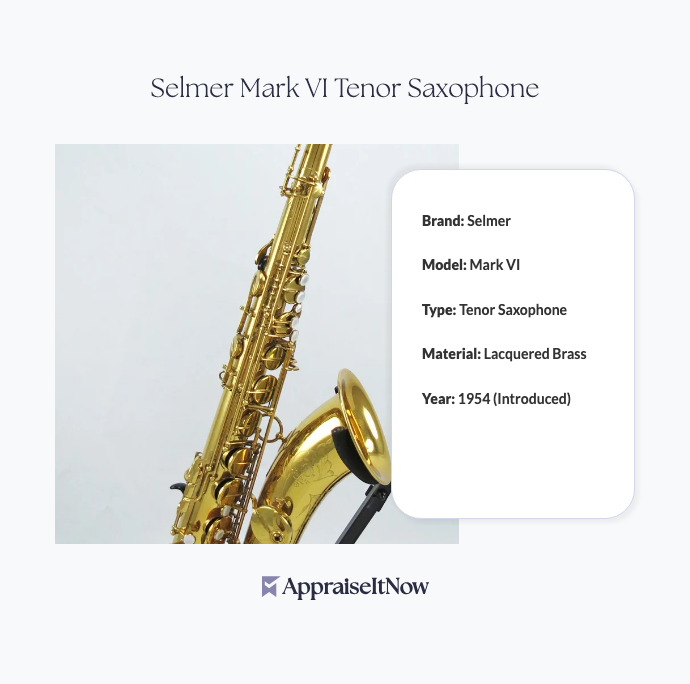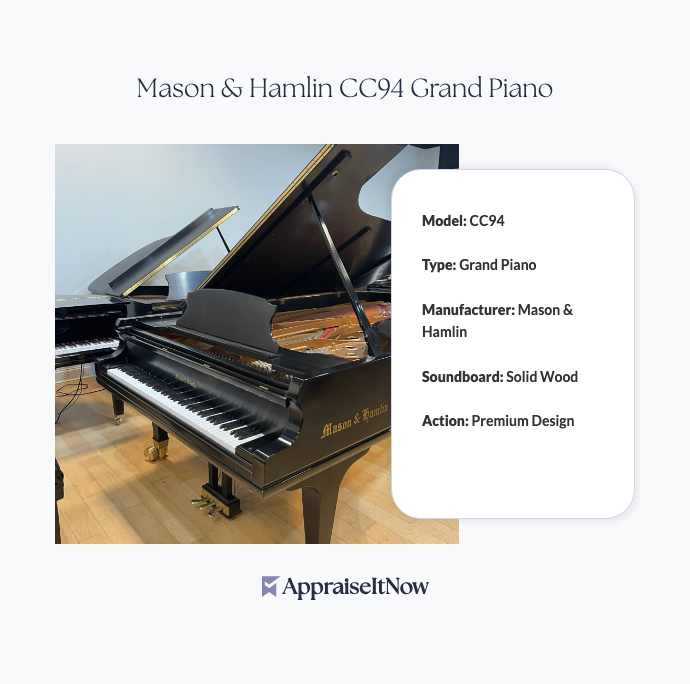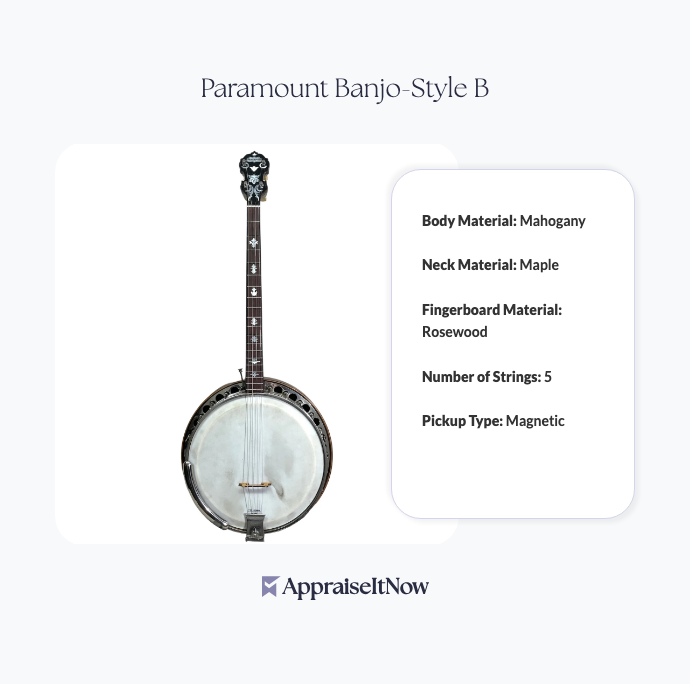<h1>How to Get Your Selmer Mark VI Tenor Saxophone Appraised</h1>
<p>If you own a Selmer Mark VI tenor saxophone, you're holding one of the most coveted instruments in jazz history. Whether you're considering selling, need documentation for insurance purposes, or want to verify its authenticity and market value, a professional appraisal provides the expertise and documentation you need. Understanding what drives the <strong>$5,000 to $12,000</strong> valuation range helps you make informed decisions about this iconic instrument.</p>
<h2>Why the Selmer Mark VI Commands Premium Value</h2>
<p>The Selmer Mark VI earned its legendary status since its introduction in 1954 through exceptional tone quality, responsive key action, and remarkable intonation that still define professional saxophone performance. Unlike newer instruments, the Mark VI represents the pinnacle of mid-20th century craftsmanship, with each horn possessing unique sonic characteristics that musicians prize above mass-produced alternatives.</p>
<p>Your Mark VI's value reflects more than just age—it represents a proven investment in musical excellence. Professional musicians across jazz, classical, and contemporary genres continue seeking out these instruments specifically because of their performance capabilities. When you explore <a href="/blog/appraising-musical-instruments-determining-the-worth-of-melodic-investments">appraising musical instruments</a>, you'll discover that vintage saxophones like the Mark VI appreciate over time, particularly when well-maintained and properly documented.</p>
<div class="callout tip"><p><strong>Market Insight</strong></p>
<p>Selmer Mark VI tenor saxophones in excellent condition often command prices at the higher end of the $5,000-$12,000 range, with rare configurations or exceptional examples occasionally exceeding this estimate.</p></div>
<h2>The Serial Number: Your First Step Toward Accurate Valuation</h2>
<p>Before seeking appraisal, locate your saxophone's serial number—typically engraved on the bell or neck. This number reveals your Mark VI's production year, which significantly impacts its desirability and value. Selmer used consistent numbering systems that experienced appraisers decode to identify exactly when your instrument was manufactured.</p>
<p>The relationship between production year and value isn't straightforward. Rather than assuming older means more valuable, collectors and appraisers recognize that certain production periods—particularly the late 1950s through early 1960s—produced Mark VIs with especially prized tonal characteristics. A serial number from 1957 might command different value than one from 1962, even if both saxophones are in identical condition. Professional appraisers specializing in vintage saxophones understand these nuances and can explain why your specific production year matters to the market.</p>
<div class="callout note"><p><strong>Authentication Step</strong></p>
<p>Verify your Mark VI's authenticity by checking that the serial number appears consistently on the neck, body, and key work. Mismatched numbers or suspicious markings warrant expert evaluation.</p></div>
<h2>Condition Factors That Drive Market Price</h2>
<p>The difference between a $5,000 Mark VI and a $12,000 example typically comes down to condition and originality. When evaluating your saxophone, appraisers assess multiple dimensions that directly correlate with market value and musical performance.</p>
<p><strong>Original finish integrity</strong> matters significantly. A Mark VI with its original lacquer in excellent condition, showing only natural patina from use, typically values higher than one that's been stripped and re-lacquered, even if the refinishing was professionally executed. Many collectors specifically seek the original finish because it reflects the instrument's authentic history and often contributes to the distinctive tonal qualities players expect from a Mark VI.</p>
<p>The <strong>mechanical function and responsiveness</strong> of all pads, springs, and key mechanisms determines both playability and value. Appraisers check each key individually, testing for proper seating, smooth action, and correct regulation. A Mark VI requiring extensive pad replacement or key work might value significantly lower than one needing only routine maintenance. Similarly, any corrosion inside the bore, dents on the body, or bent key work reduces value proportionally to the repair costs needed to restore full functionality.</p>
<p><strong>Originality of components</strong> also influences appraisal value. Mark VIs with all original pads, springs, and corks in working condition command premiums over instruments that have undergone extensive internal rebuilding. However, this doesn't mean a well-maintained saxophone is worth less—rather, the type and extent of any restoration work directly impacts the valuation.</p>
<h2>Repairs and Restoration: Understanding Their Impact</h2>
<p>If your Mark VI has undergone professional repairs or restoration, comprehensive documentation of this work becomes essential for accurate appraisal. Professional pad jobs, spring replacements, and key regulation work performed by qualified technicians actually preserve or enhance value when properly documented. Conversely, amateur repairs, non-original parts substitutions, or modifications lower market value significantly.</p>
<p>The question of whether repairs help or hurt value depends entirely on their quality and documentation. A Mark VI with a recent complete overhaul by a respected saxophone technician, supported by receipts and service records, may appraise higher than an identical untouched example requiring extensive restoration work. Appraisers factor in both the current playable condition and the cost of bringing an unrepaired instrument to equivalent status.</p>
<div class="callout tip"><p><strong>Documentation Advantage</strong></p>
<p>Maintain detailed records of any professional maintenance, repairs, or restoration work. Photos documenting before/after condition and technician invoices significantly strengthen your appraisal value.</p></div>
<h2>Original vs. Refurbished: What the Market Prefers</h2>
<p>One of the most common questions musicians ask concerns whether originality or playability should take priority—and how this affects value. The market recognizes that a fully functional, recently maintained Mark VI typically values higher than a pristine but non-functional example requiring significant restoration investment. However, completely original (though possibly needing work) instruments sometimes command premiums among collectors seeking authentic vintage specimens.</p>
<p>Professional appraisers balance these considerations by evaluating what attracted the previous owners and current collectors to Mark VI saxophones specifically. Most buyers seek instruments they can perform on immediately, meaning a well-maintained Mark VI with documented restoration often appraises higher than an original example in poor playing condition. Understanding this market reality helps you prioritize maintenance decisions that protect your investment.</p>
<h2>Provenance and Ownership History</h2>
<p>Your Mark VI's ownership history can influence its market value, particularly if documented professionally. Saxophones with verifiable performance history—perhaps owned by a respected local jazz musician, or documented as used in specific performances or recordings—carry compelling narratives that appeal to collectors. However, even without celebrity ownership, a clean chain of title and documented care history supports higher valuations.</p>
<p>When preparing for appraisal, gather any documentation you possess regarding your saxophone's ownership, including receipts from purchases, service records from technicians, or any communication with previous owners. This information, combined with <a href="/blog/appraising-personal-property-for-purchase-and-sale">proper personal property appraisal practices</a>, creates a comprehensive valuation foundation that appraisers use to establish fair market value.</p>
<h2>Selecting a Qualified Saxophone Appraiser</h2>
<p>Not all appraisers possess the specialized knowledge required for accurate Mark VI valuation. When seeking professional appraisal, look for credentials demonstrating expertise in <a href="/blog/assessing-the-value-of-musical-instruments-appraisals-of-vintage-guitars-pianos-and-violins">assessing the value of vintage musical instruments</a>. The most credible appraisers hold certifications from recognized organizations including <strong>AAA (American Association of Appraisers)</strong>, <strong>ISA (International Society of Appraisers)</strong>, <strong>ASA (American Society of Appraisers)</strong>, <strong>CAGA (Canadian Association of Personal Property Appraisers)</strong>, or <strong>AMEA (American Musical Instrument Society)</strong>.</p>
<p>Beyond credentials, an experienced appraiser should demonstrate deep familiarity with Mark VI variations, production history, market trends, and the specific factors that distinguish high-value examples from standard instruments. They should be prepared to explain their valuation methodology and provide detailed documentation suitable for insurance companies, estate planning, or sale transactions. When evaluating appraisers, ask about their experience specifically with vintage saxophones and Selmer instruments—general appraisers without this specialty knowledge may significantly misvalue your Mark VI.</p>
<div class="callout note"><p><strong>Appraiser Selection</strong></p>
<p>Choose appraisers who specialize in musical instruments and hold USPAP compliance certifications, ensuring your appraisal meets professional standards and legal requirements.</p></div>
<h2>Documentation and Photos for Online Appraisal</h2>
<p>If you're pursuing remote appraisal services, providing comprehensive documentation significantly improves accuracy. High-quality photographs from multiple angles help appraisers assess condition, finish quality, and any damage or repairs. Include close-up images of the serial number from various components, the bell interior, pad condition, and any area showing wear or restoration work.</p>
<p>Written descriptions should detail your instrument's current playing condition, any known service history, and specific observations about tone quality if you're experienced enough to evaluate these characteristics. Documentation of when and where you acquired the saxophone, along with any receipts or provenance information, strengthens the appraisal's reliability. This comprehensive approach mirrors best practices for <a href="/blog/tips-for-obtaining-accurate-personal-property-appraisals">obtaining accurate personal property appraisals</a> across all collectable categories.</p>
<h2>Market Trends and Investment Considerations</h2>
<p>The Selmer Mark VI tenor saxophone market has demonstrated consistent strength, with values appreciating steadily over recent decades. Unlike some vintage instruments that fluctuate dramatically, Mark VIs maintain reliable demand from both performing musicians and serious collectors. This market stability reflects the instrument's proven superiority in tone and playability—factors that transcend temporary collecting trends.</p>
<p>Current market dynamics show particular demand for Mark VIs from the late 1950s and early 1960s production years, which command premiums over earlier or later examples. However, even instruments from other periods retain strong value provided they're in good condition. The finite supply—production has long ceased—combined with continued demand from new generations of musicians ensures ongoing appreciation potential. Understanding these dynamics helps you recognize whether your Mark VI represents an undervalued opportunity or a fairly-priced acquisition.</p>
<h2>Insurance and Estate Planning Applications</h2>
<p>Whether you need appraisal for insurance coverage, estate planning, or charitable donation documentation, a professional valuation from a credentialed appraiser provides the formal documentation required by financial institutions and tax authorities. Unlike casual estimates from local music shops, USPAP-compliant appraisals carry legal weight and withstand regulatory scrutiny. This becomes particularly important for <a href="/blog/protecting-your-valuables-why-homeowners-need-regular-appraisals">protecting your valuables through proper appraisals</a> and ensuring your insurance coverage reflects current market values.</p>
<p>Your appraiser should provide a detailed written report including photographs, condition assessment, comparable sales analysis, and the specific factors supporting the valuation. This documentation becomes invaluable if you need to file an insurance claim, establish gift or estate values, or defend your instrument's worth during any transaction or legal proceeding.</p>
<h2>Counterfeits and Authentication Concerns</h2>
<p>A persistent challenge in the vintage saxophone market involves authentication of Mark VI instruments. While genuine Selmer Mark VIs vastly outnumber counterfeits, sophisticated fakes do exist, particularly in overseas markets. Professional appraisers trained in Mark VI authentication can identify genuine instruments by examining construction details, materials, mechanical precision, and serial number verification against Selmer's production records.</p>
<p>Genuine Mark VIs exhibit specific characteristics in their key work, engraving quality, and internal construction that counterfeiters struggle to replicate convincingly. An experienced appraiser can identify these markers quickly, protecting you from purchasing a sophisticated fake or helping establish authenticity for insurance and sales purposes. This expertise represents substantial value beyond the appraisal price alone.</p>
<div class="callout tip"><p><strong>Authentication Confidence</strong></p>
<p>Reputable appraisers verify authenticity through serial number research, construction analysis, and comparison with documented examples, providing confidence in your instrument's legitimacy.</p></div>
<h2>Production Numbers and Scarcity Considerations</h2>
<p>Selmer manufactured thousands of Mark VI saxophones during their production run, making them more accessible than certain ultra-rare vintage instruments. However, this production volume shouldn't diminish appreciation for the Mark VI's significance or value. The relevant scarcity metric involves functional, well-maintained examples in the current market—not theoretical total production numbers. Each year sees Mark VI saxophones retire from active use, move into collections, or require restoration work that removes them from the playing market. This gradual reduction in available inventory supports continued valuation stability and appreciation potential.</p>
<p>Understanding production history also helps appraisers contextualize your specific instrument within the broader Mark VI market. The question of which production years or serial number ranges command highest value receives clear answers from appraisers familiar with Mark VI market history and current collector preferences.</p>
<h2>Preparing for Your Appraisal Appointment</h2>
<p>Whether pursuing in-person or remote appraisal services, proper preparation ensures accurate valuation. Clean your Mark VI thoroughly using appropriate techniques that don't damage the finish or mechanics—avoid harsh chemicals or abrasive materials that could reduce value. Document any repairs or service work performed, including dates and service provider names. Write down your questions about valuation methodology and market factors affecting your specific instrument.</p>
<p>For in-person appraisals, have your saxophone in playable condition if possible, as appraisers may need to test key function and listen to tonal characteristics. However, if your Mark VI requires significant restoration work, inform the appraiser beforehand so they can factor restoration costs into their valuation analysis. This transparency ensures the appraisal accurately reflects your instrument's current condition and market value.</p>
<hr />
<div class="callout note"><p><strong>Key Takeaway</strong></p>
<p>A certified appraisal of your Selmer Mark VI tenor saxophone provides the expert documentation needed for accurate valuation, insurance coverage, estate planning, or sales transactions. By understanding the factors that drive market value—production year, condition, originality, and maintenance history—and working with credentialed specialists in vintage instruments, you gain confidence in your instrument's worth while protecting your investment in this iconic piece of musical history.</p></div>







.avif)







